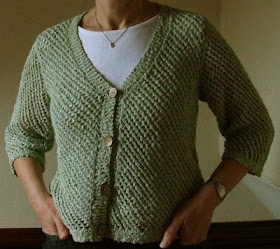I have recently finished a light summer cardigan in a simple lacy stitch - I haven't written about it before because I wasn't sure if it was going to work out, but I'm pleased with the result. So fortunately, I don't have to disown it as a failed experiment , and I am wearing it a lot.
 |
| Sirocco DK |

The pattern is distantly based on Blithe by Marie Wallin, that appeared in Rowan magazine 47. But that is designed for an Aran weight yarn (Rowan Summer Tweed) and I have used a DK yarn, and I have used a much simpler stitch pattern, and I wanted to make it longer and not so loose around the waist. So not very similar at all.
Another change is that I wanted to try knitting the button band at the same time as the cardigan fronts. Knitting a separate button band and sewing it on afterwards is one of my least favourite jobs. (Picking up stitches to knit the button band sideways is even worse.) I knitted the bands in garter stitch - not a stitch I usually like, but it seemed appropriate for this yarn. It turned out to be a good choice. A recent issue of The Knitter (Issue 21) has a pattern with built-in button bands, and the magazine discusses when they are likely to work: "Do you wonder why so many patterns ask you to work a separate button band and sew it on so that it fits when slightly stretched?" Yes I do. "It's necessary to stop the bands from flaring out at the edges." It goes on to say that you can get the same stretching effect in a built-in button band if you choose a stitch that has more rows per inch than the body of the cardigan, and so then the band will lie flat. Garter stitch does have more rows per inch than both stocking stitch and the lace stitch I used for the cardigan, so my button bands have worked. I did still have to knit the last few inches to go round the back of the neck, separately, and then graft them together,but that's not too much of a chore. On the fronts, the button bands look well, and I think it would have been hard to achieve such neat results if they were sewn on.
Sewing with this yarn was clearly not going to be possible. The advice that I have read for this situation is to use a yarn of similar weight and composition, but I think that in general I would rather use a sewing thread - easier to find a good colour match, and likely to be cheaper too. In this case, the yarn was constructed with an even thread of similar thickness to sewing thread wrapped around a much more irregular ply, so I unspun (?) it to extract lengths of that thread and used that for sewing up. That has the advantage of being an exact colour match, obviously.
A couple of things I would change if I were knitting it again. The sleeves are rather loose, which I think is due to the derivation from Blithe, judging by the Blithe projects posted on Ravelry. On the other hand, that means that I can easily wear the cardigan over a top with sleeves, which is useful now that the weather is turning chillier. The other thing is that the stitch patttern is not symmetric, and so the fabric is not quite square (though that wasn't evident from my test swatch). But I am putting up with that, and hoping that no-one else notices.



What a lovely cardigan, Barabara! I don't suppose you remembervthe stitch pattern you used after all this time?
ReplyDeleteI've just re-read what I wrote, and I think that the stitch pattern was just yarn over, knit 2 together all the way across. But as I mentioned in the post, the stitch pattern isn't symmetrical, so the pattern pieces weren't quite square. It wasn't obvious in the cardigan, unless you really looked, but maybe in a different yarn it would be a problem.
Delete